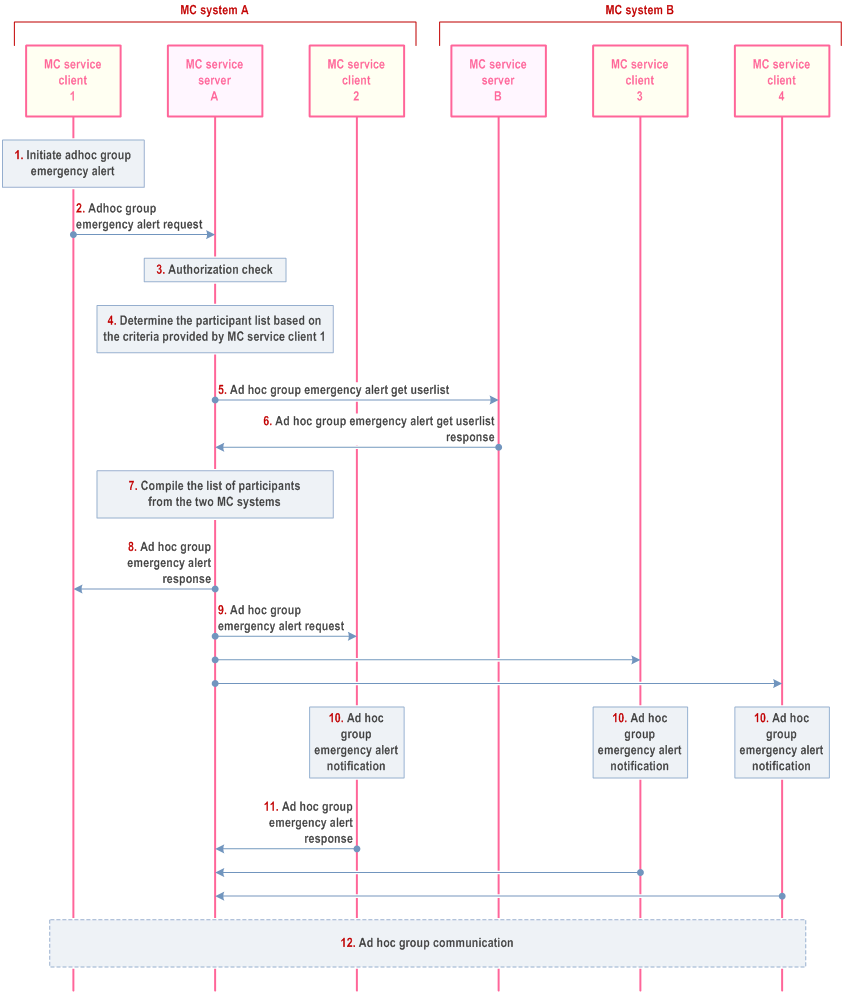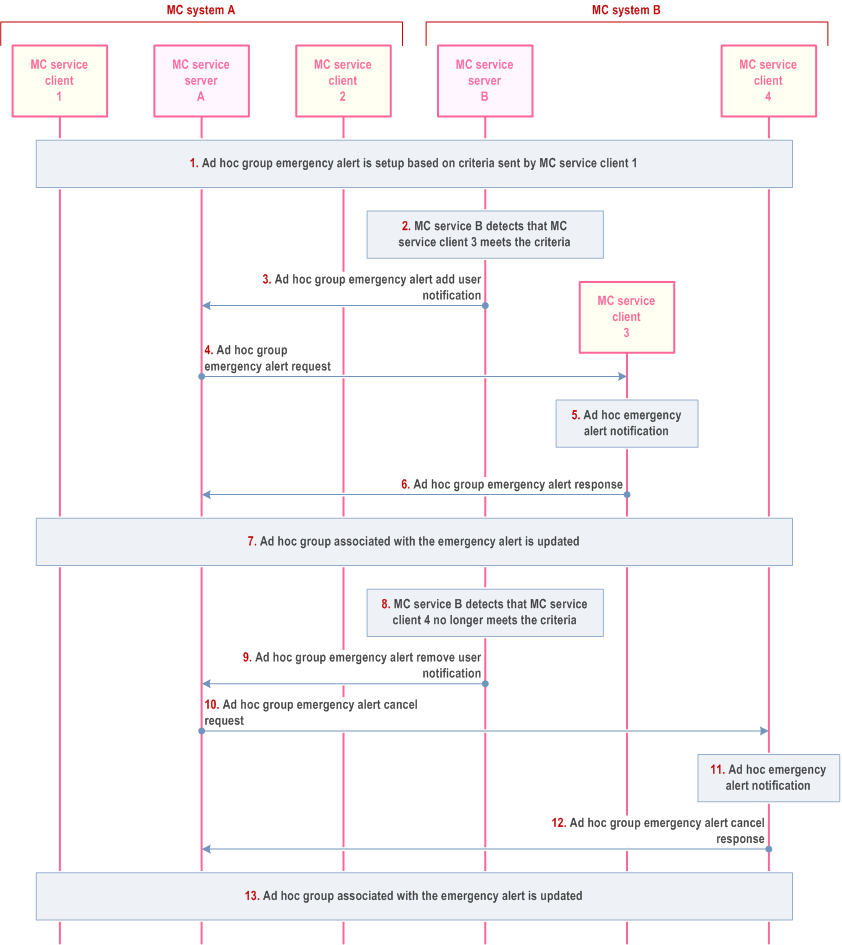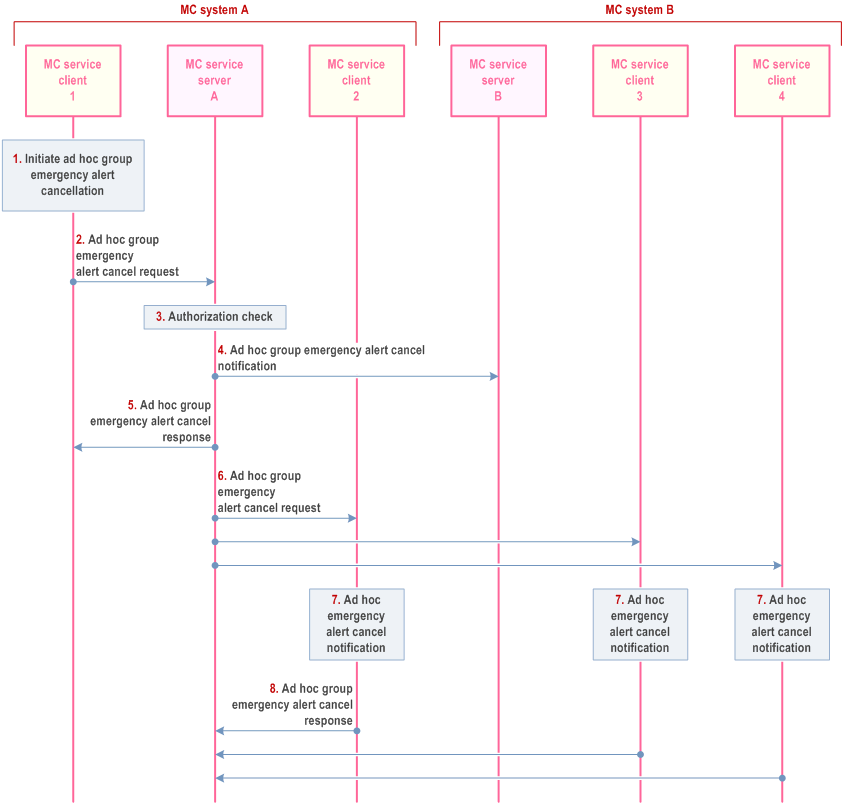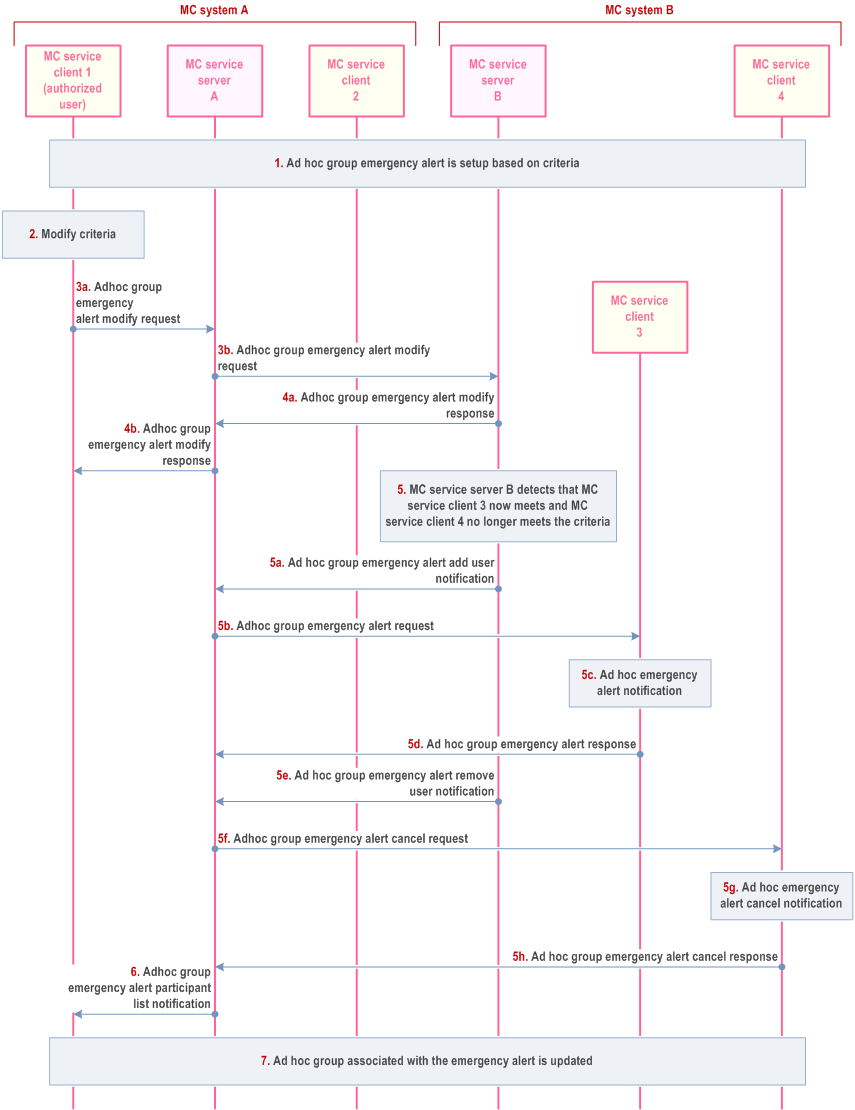Content for TS 23.280 Word version: 19.2.0
1…
5…
5.2.8…
6
7…
7.3.2
7.4…
7.4.3…
7.5…
8…
9…
9.2.2…
9.2.2.2…
9.3…
10…
10.1.2…
10.1.3…
10.1.4.3…
10.1.4.5…
10.1.5…
10.1.6…
10.2…
10.2.3…
10.2.4.2…
10.2.4.3…
10.2.5…
10.2.7…
10.3…
10.6…
10.7…
10.7.3…
10.7.3.4…
10.7.3.7…
10.7.3.7.3
10.7.3.8…
10.7.3.10…
10.8…
10.8.4…
10.8.5…
10.9…
10.9.3…
10.9.3.5…
10.9.3.8…
10.9.3.9…
10.9.3.9.3…
10.9.3.9.4…
10.9.3.10…
10.9.3.10.4…
10.9.3.10.6…
10.10…
10.10.1.2.3…
10.10.2…
10.10.3…
10.10.3.3…
10.10.3.4…
10.11…
10.11.5…
10.12…
10.13…
10.13.3…
10.13.7…
10.13.10…
10.14…
10.15…
10.15.3…
10.15.3.3…
10.15.3.4…
10.16…
10.17…
10.17.3…
10.17.5…
11…
11.3…
11.5…
11.5.2…
11.5.3…
11.5.3.3.2A…
11.5.4…
A…
B…
C…
10.10.3.4 Procedures within multiple MC systems
10.10.3.4.1 Ad hoc group emergency alert initiation
10.10.3.4.2 Updating the participant list of an ongoing ad hoc group emergency alert
10.10.3.4.3 Ad hoc group emergency alert cancel
10.10.3.4.4 Modifying the criteria for determining the participants during an ongoing ad hoc group emergency alert
...
...
10.10.3.4 Procedures within multiple MC systems p. 247
10.10.3.4.1 Ad hoc group emergency alert initiation p. 247
Figure 10.10.3.4.1-1 illustrates the procedure for initiating of ad hoc emergency alert within multiple MC systems.
Preconditions:
- The MC service user 1 belonging to MC system A initiates an ad hoc group emergency alert that involves MC service users from MC system A and MC system B.
- The MC system A and MC system B are interconnected.

Step 1.
The MC service server continuously checks whether other MC service clients meet or if participating MC service clients no longer meet the criteria for the ad hoc group emergency alert.
The MC service user 1 at the MC service client 1 initiates an ad hoc group emergency alert to an ad hoc group with participants satisfying specific criteria. The MC service user may add additional information describing the reason for sending the alert.
Step 2.
The MC service client 1 sends an ad hoc group emergency alert request containing the details of the criteria to be applied by the MC service server A for determining the participants list. The MC service client 1 may set its MC service emergency state. The MC service user at the MC service client 1 may select a functional alias used for the MC service group emergency alert. If the MC service client 1 is in an MC service emergency state, the MC service emergency state is retained by the MC service client 1 until explicitly cancelled.
Step 3.
The MC service server A checks whether the MC service user of MC service client 1 is authorized for initiation of ad hoc group emergency alert and whether the request is supported. The MC service server checks whether the provided functional alias, if present, can be used and has been activated for the user.
Step 4.
The MC service server A sends the ad hoc group emergency alert request return to the MC service user 1 containing the result of whether the ad hoc group emergency alert is authorized or not. If the ad hoc group emergency alert request is not authorized, the MC service server and the MC service client 1 shall not proceed with the rest of the steps.
Step 5.
The MC service server A determines that the partner MC system B is to be involved in the initiated ad hoc group emergency alert based on the information elements provided by the MC service client 1. The MC service server A determines the list of participants within MC system A to be invited for the ad hoc group emergency alert based on the information elements provided by the MC service client 1. This information element could carry either criteria or indicator identifying the pre-defined criteria or combination of both. Furthermore, The MC service server A adds the ad hoc group ID (generated by the MC service server A in the case when the MC service ad hoc group ID created by the MC service client 1 is not acceptable or the case where the MC service ad hoc group ID was not provided by the MC service client 1) to be associated with the ad hoc group emergency alert. The MC service server A stores the ad hoc group ID together with the list of participants for the duration of the ad hoc group emergency alert.
Step 6.
The MC service server A sends an ad hoc group emergency alert get userlist request to MC service server B including the criteria to determine the list of participants from the MC system B.
Step 7.
The MC service server B sends an ad hoc group emergency alert get userlist response to MC service server A including the list of participants within MC system B. The MC service server B may apply local policies if any while determining the participants satisfying the criteria.
Step 8.
The MC service server A compiles the list of participants from both MC system A and the partner MC system B to be involved in the ad hoc group emergency alert. The MC service server A considers MC service client 2, MC service client 3 and MC service client 4 implicitly affiliated to the ad hoc group associated to the emergency alert.
Step 9.
The MC service server A sends the MC service client 1 an ad hoc group emergency alert response to confirm that the request is granted.
Step 10.
The MC service server A sends an ad hoc group emergency alert request towards MC service client 2 within the partner MC system A and, MC service client 3, MC service client 4 within the partner MC system B.
Step 11.
The MC service user 2, MC service user 3 and MC service user 4 are notified of the ad hoc group emergency alert.
Step 12.
The MC service client 2, MC service client 3 and MC service client 4 send an ad hoc group emergency alert response back to MC service server A
Step 13.
10.10.3.4.2 Updating the participant list of an ongoing ad hoc group emergency alert p. 249
Figure 10.10.3.4.2-1 illustrates updating the participant list of an ongoing ad hoc group emergency alert within multiple MC systems. This includes scenario of MC service users entering and leaving an ongoing ad hoc emergency alert.
Preconditions:
- An ad hoc group emergency alert has been initiated by MC service user 1 within MC system A, and a related ad hoc group exists.
- The MC service server A and MC service server B are aware of the criteria sent by MC service client 1 related to the ongoing ad hoc group emergency alert.
- MC system A and MC system B are interconnected.

Step 1.
An ad hoc group emergency alert has been established based on a set of criteria sent by MC service client 1 upon initiating the ad hoc emergency alert. The MC service server A considers MC service client 3 implicitly affiliated to the ad hoc group associate to the emergency alert.
Step 2.
MC service server B detects that MC service client 3 meets the criteria of the ongoing ad hoc group emergency alert initiated at MC system A.
Step 3.
MC service server B sends an ad hoc group emergency alert add user notification including the identity of MC service client 3 to be added to the ad hoc group associated to the ongoing emergency alert.
Step 4.
The MC service server A sends an ad hoc group emergency alert request to MC service client 3.
Step 5.
The MC service user 3 is notified of entering an ongoing ad hoc group emergency alert.
Step 6.
The MC service client 3 sends the MC service server A an ad hoc group emergency alert response.
Step 7.
The MC service server A updates the participant list of the MC service group associated with the ongoing ad hoc group emergency alert. The MC service server A may send a notification to authorized users indicating the addition of MC service client 3 to the ad hoc group.
Step 8.
The MC service server B detects that MC service client 4 no longer meets the criteria of the ongoing ad hoc group emergency alert. The MC service server A deaffiliates the MC service client 4 from the ad hoc group associated to the emergency alert.
Step 9.
The MC service server B sends the MC service server A an ad hoc group emergency remove user notification.
Step 10.
MC service server A sends the MC service client 4 an ad hoc group emergency alert cancel request.
Step 11.
The MC service user 4 is notified of leaving an ad hoc group emergency alert.
Step 12.
The MC service client 4 sends the MC service server A an ad hoc emergency alert cancel response.
Step 13.
The ad hoc group associated with the ongoing ad hoc emergency alert is updated. The MC service server A may send a notification to authorized users indicating the removal of the MC service client 4.
10.10.3.4.3 Ad hoc group emergency alert cancel p. 251
Figure 10.10.3.4.3-1 illustrates the procedure once an MC service client cancels an ongoing ad hoc group emergency alert.
Preconditions:
- An ad hoc group emergency alert is ongoing with participants within MC system A and MC system B.
- MC system A and MC system B are interconnected.

Step 1.
The MC service user 1 decides to cancel an ongoing ad hoc group emergency alert.
Step 2.
MC service client 1 sends the MC service server A an ad hoc group emergency alert cancel request. If the cancel request is sent for another MC service user that initiated this emergency alert, that user`s MC service ID shall be included in the cancel request.
Step 3.
MC service server A checks whether the MC service client 1 is authorized to cancel an ongoing ad hoc group emergency alert. The MC service server A checks whether the provided functional alias, if present, can be used and has been activated for the user.
Step 4.
The MC service server A sends the ad hoc group emergency cancel alert request return to the MC service user 1 containing the result of whether the ad hoc group emergency cancel request is authorized or not. If the ad hoc group emergency cancel alert request is not authorized, the MC service server and the MC service client 1 shall not proceed with the rest of the steps.
Step 5.
The MC service server A sends an ad hoc emergency alert cancel notification to the MC service server B at the partner MC system B.
Step 6.
The MC service server A sends MC service client 2, MC service client 3 and MC service client 4 ad hoc group emergency alert cancel request.
Step 7.
The MC service user 2, MC service user 3 and MC service user 4 are notified of the ad hoc group emergency alert cancellation.
Step 8.
The MC service client 2, MC service client 3 and MC service client 4 sends ad hoc group emergency alert cancel response to the MC service server A. If there is no other communication in the ad hoc group or once the communication in the ad hoc group is terminated, the ad hoc group ceases to exist.
Step 9.
The MC service server A sends an ad hoc group emergency alert cancel response to MC service client 1.
10.10.3.4.4 Modifying the criteria for determining the participants during an ongoing ad hoc group emergency alert |R19| p. 252
Figure 10.10.3.4.4-1 illustrates when the alerting user modifies the criteria for determining the list of participants of an ongoing ad hoc group emergency alert between multiple MC systems. This includes a scenario of MC service users entering and leaving an ongoing ad hoc emergency alert.
Preconditions:
- The MC service user at the MC service client 1 is authorized to modify the criteria.
- The MC service server A and MC service server B are aware of the criteria related to the ongoing ad hoc group emergency alert.
- MC system A and MC system B are interconnected.

Step 1.
The MC service servers continuously check whether other MC service clients meet or if participating MC service clients no longer meet the criteria for the ad hoc group emergency alert.
An ad hoc group emergency alert has been established based on criteria sent by an authorized MC service client upon initiating the ad hoc emergency alert.
Step 2.
The MC service user at the MC service client 1 is authorized and wishes to modify the criteria for determining the list of ad hoc group emergency alert participants.
Step 3.
The MC service server A receives the ad hoc group emergency alert modify request.
Step 4.
The MC service server A checks whether MC service client 1 is authorized to modify the criteria which determines the list of ad hoc group participants.
Step 5.
The MC service server A sends the ad hoc group emergency alert modify request return to MC service client 1 containing the result of whether modifying the criteria for determining the participants of the ad hoc group is authorized or not. If the ad hoc group emergency alert modify request is not authorized, the MC service server and the MC service client 1 shall not proceed with the rest of the steps.
Step 6.
If MC service server A identifies that the criteria require to add participants from another MC system then MC service server A sends an ad hoc group emergency alert request to MC service server B at MC system B.
Step 7a/b.
The MC service server A receives the ad hoc group emergency alert modify response and forwards the response to MC service client 1 in MC system A.
Step 8.
MC service server B detects that MC service client 3 meets the criteria for the ongoing ad hoc group emergency alert initiated at MC system A.
Step 8a.
MC service server B sends an ad hoc group emergency add user notification message towards MC service server A.
Step 8b.
MC service server A sends an ad hoc group emergency alert request towards MC service client 3.
Step 8c.
The MC service user 3 is notified of entering an ongoing ad hoc group emergency alert.
Step 8d.
MC service client 3 sends an ad hoc group emergency alert response towards MC service server A.
Step 8e.
MC service server B sends an ad hoc group emergency remove user notification message towards MC service server A.
Step 8f.
MC service server A sends an ad hoc group emergency alert cancel request towards MC service client 4.
Step 8g.
The MC service user 4 is notified of leaving an ongoing ad hoc group emergency alert.
Step 8h.
MC service client 4 sends an ad hoc group emergency alert cancel response towards MC service server A.
Step 9.
The authorized user on MC service client 1 is notified with the MC service IDs of those MC service users who are currently in the ad hoc group. This notification may be sent to the authorised MC service user by the MC service server A more than once during the call when MC service users join or leave the ad hoc group.
Step 10.
The MC service server A adds MC service client 3 to the ad hoc group emergency alert and removes MC service client 4 from the ad hoc group emergency alert.